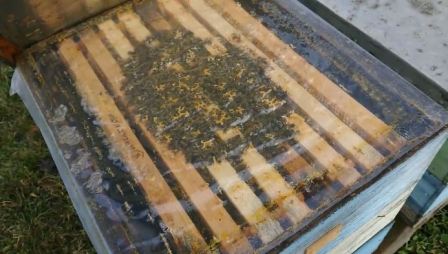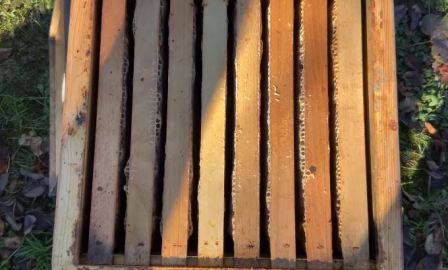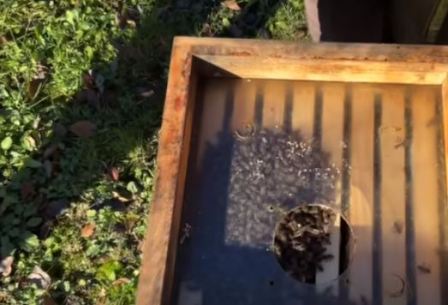How a beekeeper can lower a cluster of bees down in the fall
 In the fall, a beekeeper, having prepared the bees for the winter, may find that in some families, the bees have formed a cluster under the upper bars of the frames or in the upper case, if we are talking about a multi-case hive. If the cluster of bees is not lowered down in the fall, the bees will die in the winter. Let's consider how a beekeeper can solve the problem and lower the cluster of bees down. Read to the end - it will be useful and interesting!
In the fall, a beekeeper, having prepared the bees for the winter, may find that in some families, the bees have formed a cluster under the upper bars of the frames or in the upper case, if we are talking about a multi-case hive. If the cluster of bees is not lowered down in the fall, the bees will die in the winter. Let's consider how a beekeeper can solve the problem and lower the cluster of bees down. Read to the end - it will be useful and interesting!
When and where a cluster of bees is formed for the winter

Photo: Where should the cluster of bees be in October? The correct answer is that the bees should gather in a cluster at the bottom of the frames opposite the entrance.
Considering this issue, it is impossible not to touch on the topic of the formation of a cluster of bees for the winter in general. First, let's determine when the bees gather in a cluster for the winter. In this case, there is no point in looking at the calendar. It is more important to know at what temperature the bees gather in a cluster. As a rule, when the temperature drops below 10 C, the bees form a cluster.
The correct location of the cluster is on the lower part of the frames. The bees form a cluster for the winter, crowding into the interframe space, partially hanging below the frames, and also climbing into empty cells after the honey from them has been eaten. The less honey in the frames, the higher the cluster of bees is formed. In this case, the bees try to gather in a cluster opposite the entrance, initially a little closer to the front wall of the hive. In this case, the bees, eating food, gradually rise up the frames, and having reached the upper bar, the cluster begins to move to the back wall of the hive.
However, sometimes a beekeeper can, having fully prepared the apiary for winter - having grown young bees, treated them, fed the bees in winter, formed a nest and insulated it, united weak families in the fall, created ventilation, covered or opened the necessary flight holes and mesh bottom, the beekeeper still sees that the bees have formed a cluster incorrectly.
The most common forms of incorrect cluster formation are when a cluster of bees has gathered at the back wall of the hive or the bees form a cluster of bees in the upper part of the frames or in the upper body of a multi-body hive. Why this happens and what it leads to will be discussed below. Also, the beekeeper may find that the bees have not gathered in a cluster at all.
Why bees form a cluster incorrectly
As a rule, there are two reasons why bees gather in a cluster at the top of the frames.
The first reason why bees have incorrectly settled in a cluster is excessive insulation. Bees feel the warmth at the top and gather in a cluster at the top.
The second reason, as a rule, is typical for multi-hull hives, is that the queen has risen up and the last brood has come out in the upper hull, in this case the bees can remain in the upper hull and gather in a cluster for the winter in it.
If the bees have gathered in a cluster at the top of the hive, then the family will die in winter from hunger, despite the fact that there is a lot of food in the hive, so it is necessary to lower the cluster of bees down in the fall without fail.
The next thing a beekeeper can see is a case when the bees gather at the back wall of the hive. In this case, the bees may also not have enough food for a long winter, but in the case of a short winter, the bees have enough food, in addition, the beekeeper can feed such a family with candy in February.
How to lower a cluster of bees down in autumn

Photo: bees have sat down in a cluster incorrectly, it is still autumn, and they are in the upper body, what to do, how to lower a cluster of bees down in autumn
The beekeeper needs to check in the autumn how the bees have gathered in a cluster for the winter. It is advisable to do the check when the bees have already formed a cluster. It is important to remember that in autumn, the sun can still warm and the clusters can be loose, the cluster can fall apart, the bees can gather a cluster in another place. Remember, at what temperature does a cluster of bees disintegrate? When the temperature reaches above 10 C, the cluster of bees disintegrates.
If the beekeeper finds that the bees have sat down in a cluster incorrectly, what to do? How to lower a cluster of bees down in autumn so that it takes the right place?
The beekeeper's actions are quite simple. The bees must feel the cold at the top to lower the cluster of bees down. Therefore, in the morning of a fine day, the beekeeper removes excess insulation, leaving only the canvas; if necessary, you can even remove the roof of the hive and leave one canvas, pressing it down with something heavy so that the wind does not blow it away. If the hive has a mesh bottom, then it is covered with a latch. Literally in a day, the bees feel that the floor of the hive is warmer than the roof and go down, where they gather in a cluster for the winter. It is important to do this work not in the evening, but in the morning, so that the bees can calmly move down.
After the bees have gathered in a cluster correctly, the latch is removed from the mesh bottom; if the roof of the hive was removed, it is returned to its place. Insulation is not placed on the canvas, leaving only one canvas; the cold at the top will not only help lower the cluster of bees down, but also leave it at the bottom.